Assessing the Combined Influence of Indoor Air Quality and Visitor Flow Toward Preventive Conservation at the Peggy Guggenheim Collection
Abstract
1. Introduction
Aim of the Work
2. Materials and Methods
2.1. The Peggy Guggenheim Collection in Venice: Strategy and Planning for Monitoring
2.2. T and RH Monitoring
2.3. Sampling and Analysis of Gaseous Pollutants
2.4. Visitor Data: Acquisition
3. Results and Discussion
3.1. T and RH Monitoring
3.2. IAQ
3.3. Effect of Visitors on NH3 Concentration
3.4. Effect of Visitors on T and RH
4. Conclusions
- Prioritize NH3 and HCHO reduction through improved ventilation during peak hours;
- Cost-effective passive samplers (as used in this study) can provide reliable data for long-term IAQ assessment to balance public access with long-term conservation goals;
- Keep to the minimum fluctuations of the number of visitors in each room;
- Limit occupancy in sensitive areas and use real-time IAQ monitoring to adjust connected HVAC systems dynamically.
Author Contributions
Funding
Institutional Review Board Statement
Informed Consent Statement
Data Availability Statement
Acknowledgments
Conflicts of Interest
Appendix A. Wasserstein Distance
Appendix B. Tracking Visitors and Visitor Flow Re-Organization
- A small Bluetooth Low Energy beacon, to be worn by the tracked visitor;
- A fleet of Raspberry Pi’s, model 3B+ (RPi’s), placed one in each room as receiving antenna and connected to the Internet by a WiFi network;
- A central server for collecting all data.

- Total duration of visit;
- time of permanence in each room;
- followed path (as a sequence of rooms).
References
- Camuffo, D. Microclimate for Cultural Heritage: Measurement, Risk Assessment, Conservation, Restoration, and Maintenance of Indoor and Outdoor Monuments; Elsevier: Amsterdam, The Netherlands, 2019. [Google Scholar] [CrossRef]
- Martellini, T.; Berlangieri, C.; Dei, L.; Carretti, E.; Santini, S.; Barone, A.; Cincinelli, A. Indoor levels of volatile organic compounds at Florentine museum environments in Italy. Indoor Air 2020, 30, 900–913. [Google Scholar] [CrossRef]
- Pagnin, L.; Wiesinger, R.; Koyun, A.N.; Schreiner, M. The effect of pollutant gases on surfactant migration in acrylic emulsion films: A comparative study and preliminary evaluation of surface cleaning. Polymers 2021, 13, 1941. [Google Scholar] [CrossRef] [PubMed]
- Colombini, M.P.; Andreotti, A.; Bonaduce, I.; Modugno, F.; Ribechini, E. Analytical strategies for characterizing organic paint media using gas chromatography/mass spectrometry. Acc. Chem. Res. 2010, 43, 715–727. [Google Scholar] [CrossRef] [PubMed]
- Blades, N.; Oreszczyn, T.; Bordass, B.; Cassar, M. Guidelines on Pollution Control in Heritage Buildings; Technical Report, Technical Report; UCL: London, UK, 2000. [Google Scholar]
- Gysels, K.; Delalieux, F.; Deutsch, F.; Van Grieken, R.; Camuffo, D.; Bernardi, A.; Sturaro, G.; Busse, H.J.; Wieser, M. Indoor environment and conservation in the Royal Museum of Fine Arts, Antwerp, Belgium. J. Cult. Herit. 2004, 5, 221–230. [Google Scholar] [CrossRef]
- Nazaroff, W.W. Indoor particle dynamics. Indoor Air 2004, 14, 175–183. [Google Scholar] [CrossRef] [PubMed]
- Pease, L.F.; Salsbury, T.I.; Anderson, K.; Underhill, R.M.; Flaherty, J.E.; Vlachokostas, A.; Burns, C.A.; Wang, N.; Kulkarni, G.; James, D.P. Size dependent infectivity of SARS-CoV-2 via respiratory droplets spread through central ventilation systems. Int. Commun. Heat Mass Transf. 2022, 132, 105748. [Google Scholar] [CrossRef]
- Paolin, E.; Strlič, M. Volatile organic compounds (VOCs) in heritage environments and their analysis: A review. Appl. Sci. 2024, 14, 4620. [Google Scholar] [CrossRef]
- Wang, N.; Ernle, L.; Bekö, G.; Wargocki, P.; Williams, J. Emission rates of volatile organic compounds from humans. Environ. Sci. Technol. 2022, 56, 4838–4848. [Google Scholar] [CrossRef]
- Permar, W.; Wielgasz, C.; Jin, L.; Chen, X.; Coggon, M.M.; Garofalo, L.A.; Gkatzelis, G.I.; Ketcherside, D.; Millet, D.B.; Palm, B.B.; et al. Assessing formic and acetic acid emissions and chemistry in western U.S. wildfire smoke: Implications for atmospheric modeling. Environ. Sci. Atmos. 2023, 3, 1620–1641. [Google Scholar] [CrossRef]
- Carvalho, L.H.; Magalhães, F.D.; Ferra, J.M. Formaldehyde emissions from wood-based panels - Testing methods and industrial perspectives. In Formaldehyde: Chemistry, Applications and Role In Polymerization; Cheng, C.B., Lin, F.H., Eds.; Nova Science Publishers, Inc.: Hauppauge, NY, USA, 2012; Chapter 2. [Google Scholar]
- Brimblecombe, P. The composition of museum atmospheres. Atmos. Environ. B 1990, 24, 1–8. [Google Scholar] [CrossRef]
- Reiss, R.; Ryan, P.B.; Koutrakis, P.; Tibbetts, S.J. Ozone Reactive Chemistry on Interior Latex Paint. Environ. Sci. Technol. 1995, 29, 1906–1912. [Google Scholar] [CrossRef] [PubMed]
- Shashoua, Y. Conservation of Plastics: Materials Science, Degradation and Preservation; Routlege: Abingdon, UK, 2008. [Google Scholar]
- Smedemark, S.H.; Ryhl-Svendsen, M.; Schieweck, A. Quantification of formic acid and acetic acid emissions from heritage collections under indoor room conditions. Part I: Laboratory and field measurements. Herit. Sci. 2020, 8, 58. [Google Scholar] [CrossRef]
- Camuffo, D.; Bernardi, A.; Sturaro, G.; Valentino, A. The microclimate inside the Pollaiolo and Botticelli rooms in the Uffizi Gallery, Florence. J. Cult. Herit. 2002, 3, 155–161. [Google Scholar] [CrossRef]
- Bonello, M.; Micallef, D.; Borg, S.P. Humidity distribution in high-occupancy indoor micro-climates. Energies 2021, 14, 681. [Google Scholar] [CrossRef]
- Jelec, P.A. The microclimate parameters change in the occupied zone inside some large-volume buildings with significant influence of the heat emission from people staying inside. In E3S Web of Conferences; EDP Sciences: Les Ulis, France, 2017; Volume 19, p. 01015. [Google Scholar] [CrossRef]
- Maekawa, S.; Ankersmit, B.; Neuhaus, E.; Schellen, H.L.; Beltran, V.; Boersma, F. Investigation into impacts of large numbers of visitors on the collection environment at Our Lord in the Attic. In Proceedings of the Museum Microclimates Conference, Copenhagen, Denmark, 19–23 November 2007; Padfield, T., Borchersen, K., Eds.; The National Museum of Denmark: København, Denmark, 2007. [Google Scholar]
- Ferdyn-Grygierek, J.; Kaczmarczyk, J.; Blaszczok, M.; Lubina, P.; Koper, P.; Bulińska, A. Hygrothermal risk in museum buildings located in moderate climate. Energies 2020, 13, 344. [Google Scholar] [CrossRef]
- La Gennusa, M.; Lascari, G.; Rizzo, G.; Scaccianoce, G. Conflicting needs of the thermal indoor environment of museums: In search of a practical compromise. J. Cult. Herit. 2008, 9, 125–134. [Google Scholar] [CrossRef]
- Schito, E.; Conti, P.; Testi, D. Multi-objective optimization of microclimate in museums for concurrent reduction of energy needs, visitors’ discomfort and artwork preservation risks. Appl. Energy 2018, 224, 147–159. [Google Scholar] [CrossRef]
- Thomson, G. The Museum Environment; Butterworths: London, UK, 1978. [Google Scholar]
- Stolow, N. Conservation and Exhibitions. Packing, Transport, Storage and Environmental Considerations; Butterworths: London, UK, 1986. [Google Scholar]
- Cirrincione, L.; La Gennusa, M.; Peri, G.; Rizzo, G.; Scaccianoce, G. Indoor parameters of museum buildings for guaranteeing artworks preservation and people’s comfort: Compatibilities, constraints, and suggestions. Energies 2024, 17, 1968. [Google Scholar] [CrossRef]
- Pretelli, M.; Signorelli, L.; De Vivo, M.A. Improving the accessibility of cultural sites during pandemic through microclimate control. The case of CapsulART applied to the MANN museum in Naples. Stud. Health Technol. Inform. 2022, 297, 507–514. [Google Scholar] [CrossRef]
- Nakielska, M.; Pawłowski, K. Conditions of the internal microclimate in the museum. J. Ecol. Eng. 2020, 21, 205–209. [Google Scholar] [CrossRef]
- Kompatscher, K. Identifying Indoor Local Microclimates for Safekeeping of Cultural Heritage. Ph.D. Thesis, Technische Universiteit Eindhoven, Eindhoven, The Netherlands, 2021. [Google Scholar]
- Perrino, C.; Catrambone, M. Development of a variable-path-length diffusive sampler for ammonia and evaluation of ammonia pollution in the urban area of Rome, Italy. Atmos. Environ. 2004, 38, 6667–6672. [Google Scholar] [CrossRef]
- De Santis, F.; Dogeroglu, T.; Fino, A.; Menichelli, S.; Vazzana, C.; Allegrini, I. Laboratory development and field evaluation of a new diffusive sampler to collect nitrogen oxides in the ambient air. Anal. Bioanal. Chem. 2002, 373, 901–907. [Google Scholar] [CrossRef] [PubMed]
- De Santis, F.; Allegrini, I.; Fazio, M.C.; Pasella, D.; Piredda, R. Development of a passive sampling technique for the determination of nitrogen dioxide and sulphur dioxide in ambient air. Anal. Chim. Acta 1997, 346, 127–134. [Google Scholar] [CrossRef]
- Gibson, L.T.; Cooksey, B.G.; Littlejohn, D.; Tennent, N.H. Determination of experimental diffusion coefficients of acetic acid and formic acid vapours in air using a passive sampler. Anal. Chim. Acta 1997, 341, 1–10. [Google Scholar] [CrossRef]
- Roadman, M.J.; Scudlark, J.R.; Meisinger, J.J.; Ullman, W.J. Validation of Ogawa passive samplers for the determination of gaseous ammonia concentrations in agricultural settings. Atmos. Environ. 2003, 37, 2317–2325. [Google Scholar] [CrossRef]
- Villanueva, F.; Colmenar, I.; Mabilia, R.; Scipioni, C.; Cabañas, B. Field evaluation of the Analyst® passive sampler for the determination of formaldehyde and acetaldehyde in indoor and outdoor ambient air. Anal. Methods 2013, 5, 516–524. [Google Scholar] [CrossRef]
- Centorrino, P.; Corbetta, A.; Cristiani, E.; Onofri, E. Managing crowded museums: Visitors flow measurement, analysis, modeling, and optimization. J. Comput. Sci. 2021, 53, 101357. [Google Scholar] [CrossRef]
- Nazaroff, W.W.; Weschler, C.J. Indoor acids and bases. Indoor Air 2020, 30, 559–644. [Google Scholar] [CrossRef]
- Spicer, C.W.; Coutant, R.W.; Ward, G.F.; Joseph, D.W.; Gaynor, A.J.; Billick, I.H. Rates and mechanisms of NO2 removal from indoor air by residential materials. Environ. Int. 1989, 15, 643–654. [Google Scholar] [CrossRef]
- Grøntoft, T. The influence of photochemistry on outdoor to indoor NO2 in some European museums. Indoor Air 2022, 32, e12999. [Google Scholar] [CrossRef]
- Tétreault, J. Polluants Dans Les Musées et Les Archives: Évaluation Des Risques, Stratégies de Contrôle et Gestion de la Preservation; Canadian Conservation Institute: Ottawa, ON, Canada, 2003. [Google Scholar]
- Weschler, C.J.; Shields, H.C.; Naik, D.V. Indoor chemistry involving O3, NO, and NO2 as evidenced by 14 months of measurements at a site in southern California. Environ. Sci. Technol. 1994, 28, 2120–2132. [Google Scholar] [CrossRef]
- Pitts JR, J.N.; Sanhueza, E.; Atkinson, R.; Carter, W.P.L.; Winer, A.M.; Harris, G.W.; Plum, C.N. An investigation of the dark formation of nitrous acid in environmental chambers. Int. J. Chem. Kinet. 1984, 16, 919–939. [Google Scholar] [CrossRef]
- Schwartz, S.E. Trace Atmospheric Constituents. Properties, Transformation and Fates; Wiley and Sons: New York, NY, USA, 1983. [Google Scholar]
- Salmon, L.G.; Nazaroff, W.W.; Ligocki, M.P.; Jones, M.C.; Cass, G.R. Nitric acid concentrations in southern California museums. Environ. Sci. Technol. 1990, 24, 1004–1013. [Google Scholar] [CrossRef]
- Febo, A.; Perrino, C. Prediction and experimental evidence for high air concentration of nitrous acid in indoor environments. Atmos. Environ. A 1991, 25, 1055–1061. [Google Scholar] [CrossRef]
- Kraševec, I.; Menart, E.; Strlič, M.; Kralj Cigić, I. Validation of passive samplers for monitoring of acetic and formic acid in museum environments. Herit. Sci. 2021, 9, 19. [Google Scholar] [CrossRef]
- Tétreault, J.; Sirois, J.; Stamatopoulou, E. Studies of lead corrosion in acetic acid environments. Stud. Conserv. 1998, 43, 17–32. [Google Scholar] [CrossRef]
- Dimitroulopoulou, C.; Lucica, E.; Johnson, A.; Ashmore, M.R.; Sakellaris, I.; Stranger, M.; Goelen, E. EPHECT I: European household survey on domestic use of consumer products and development of worst-case scenarios for daily use. Sci. Total Environ. 2015, 536, 880–889. [Google Scholar] [CrossRef] [PubMed]
- Lefebvre, M.A.; Meuling, W.J.A.; Engel, R.; Coroama, M.C.; Renner, G.; Pape, W.; Nohynek, G.J. Consumer inhalation exposure to formaldehyde from the use of personal care products/cosmetics. Regul. Toxicol. Pharm. 2012, 63, 171–176. [Google Scholar] [CrossRef]
- Li, M.; Weschler, C.J.; Bekö, G.; Wargocki, P.; Lucic, G.; Williams, J. Human ammonia emission rates under various indoor environmental conditions. Environ. Sci. Technol. 2020, 54, 5419–5428. [Google Scholar] [CrossRef]
- Weschler, C.J.; Shields, H.C.; Naik, D.V. Indoor Ozone Exposures. JAPCA 1989, 39, 1562–1568. [Google Scholar] [CrossRef]
- Motta, O.; Pironti, C.; Ricciardi, M.; Rostagno, C.; Bolzacchini, E.; Ferrero, L.; Cucciniello, R.; Proto, A. Leonardo da Vinci’s “Last Supper”: A case study to evaluate the influence of visitors on the museum preservation systems. Environ. Sci. Pollut. Res. 2021, 29, 29391–29398. [Google Scholar] [CrossRef] [PubMed]
- Ampollini, L.; Katz, E.F.; Bourne, S.; Tian, Y.; Novoselac, A.; Goldstein, A.H.; Lucic, G.; Waring, M.S.; DeCarlo, P.F. Observations and contributions of real-time indoor ammonia concentrations during HOMEChem. Environ. Sci. Technol. 2019, 53, 8591–8598. [Google Scholar] [CrossRef] [PubMed]
- Grzywacz, C.M. Monitoring for Gaseous Pollutants in Museum Environments; Getty Conservation Institute: Los Angeles, CA, USA, 2006. [Google Scholar]
- Lunden, M.M.; Revzan, K.L.; Fischer, M.L.; Thatcher, T.L.; Littlejohn, D.; Hering, S.V.; Brown, N.J. The transformation of outdoor ammonium nitrate aerosols in the indoor environment. Atmos. Environ. 2003, 37, 5633–5644. [Google Scholar] [CrossRef]
- Cristiani, E.; Piccoli, B.; Tosin, A. Multiscale Modeling of Pedestrian Dynamics; Springer: Berlin/Heidelberg, Germany, 2014. [Google Scholar]

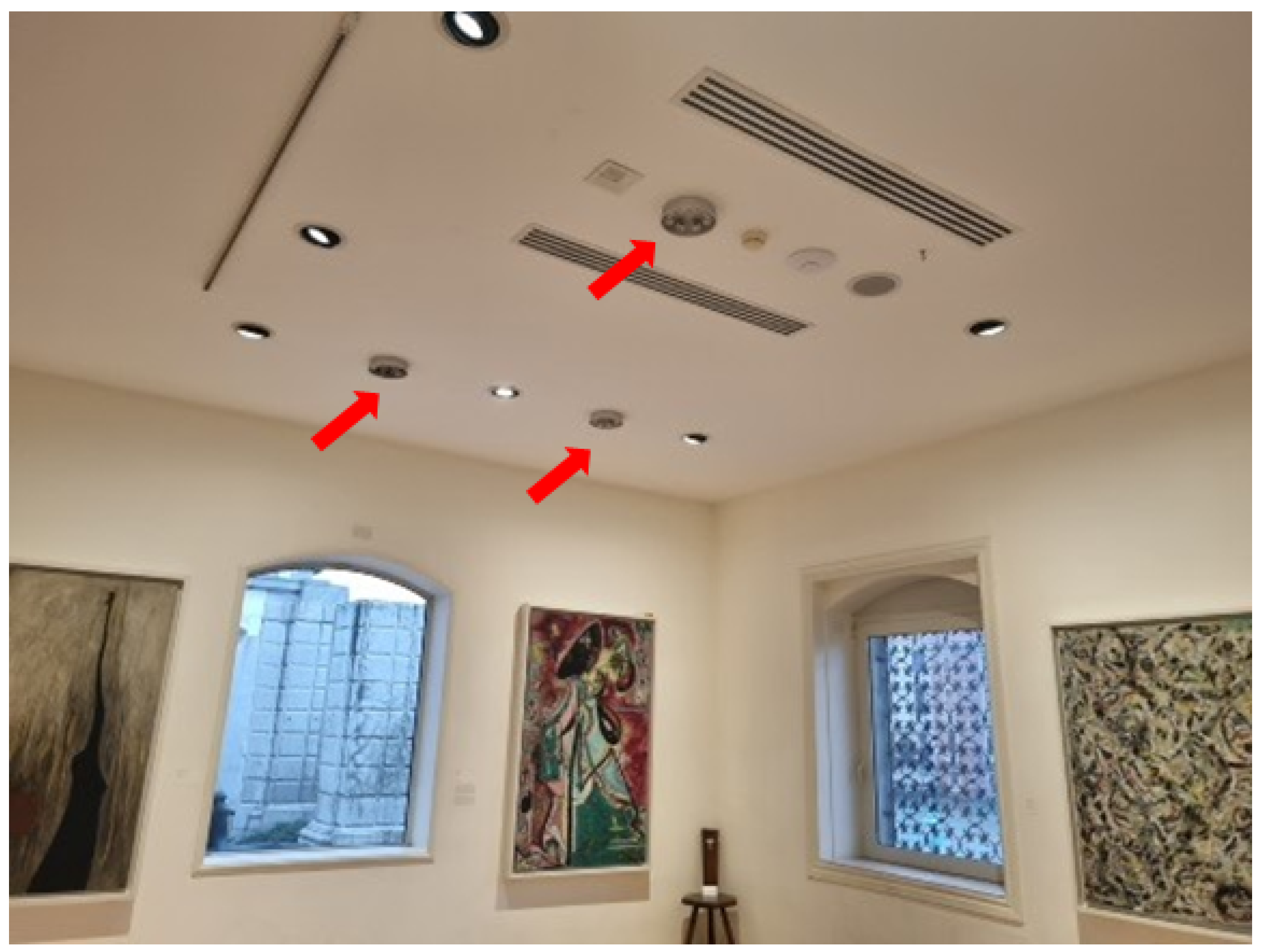
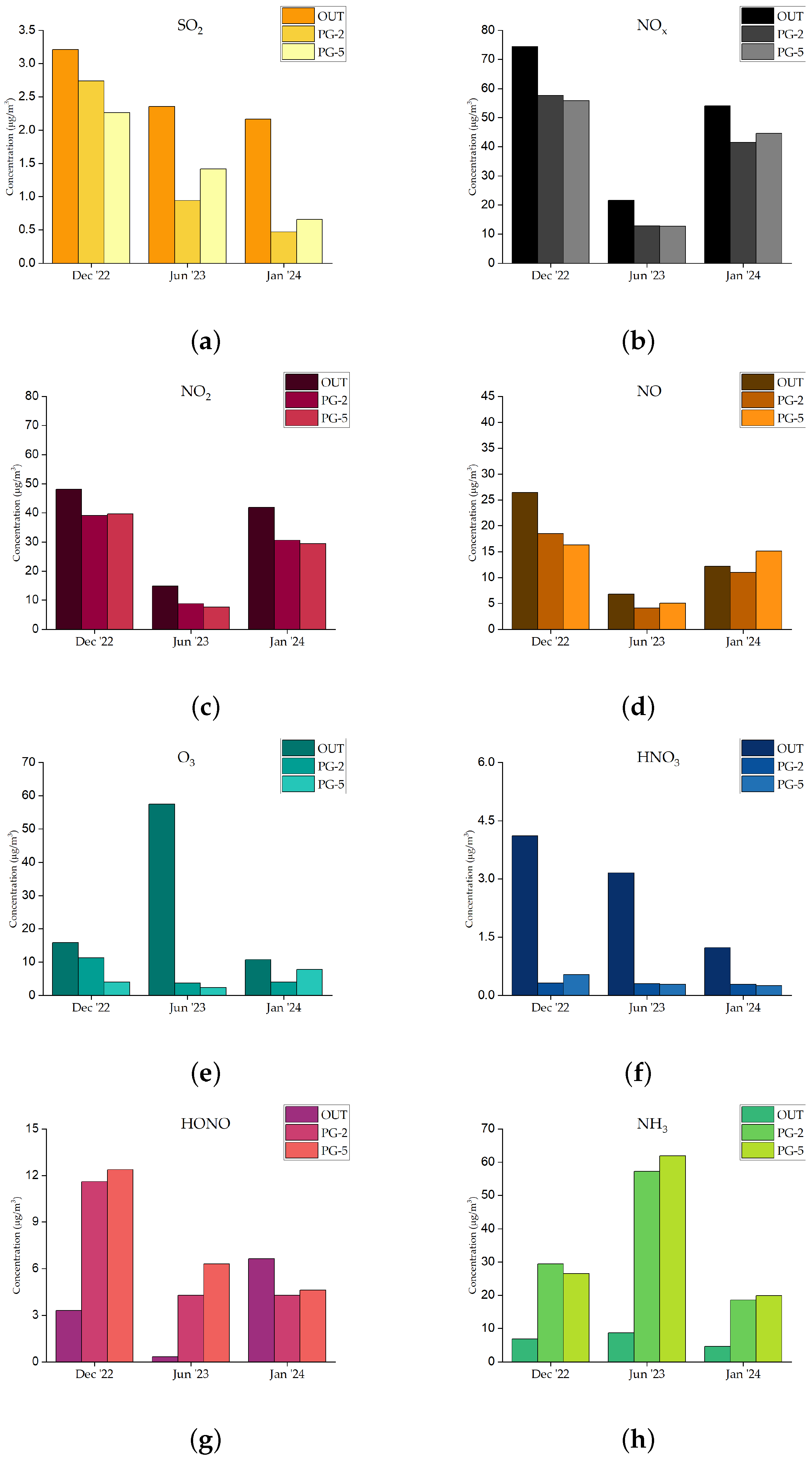
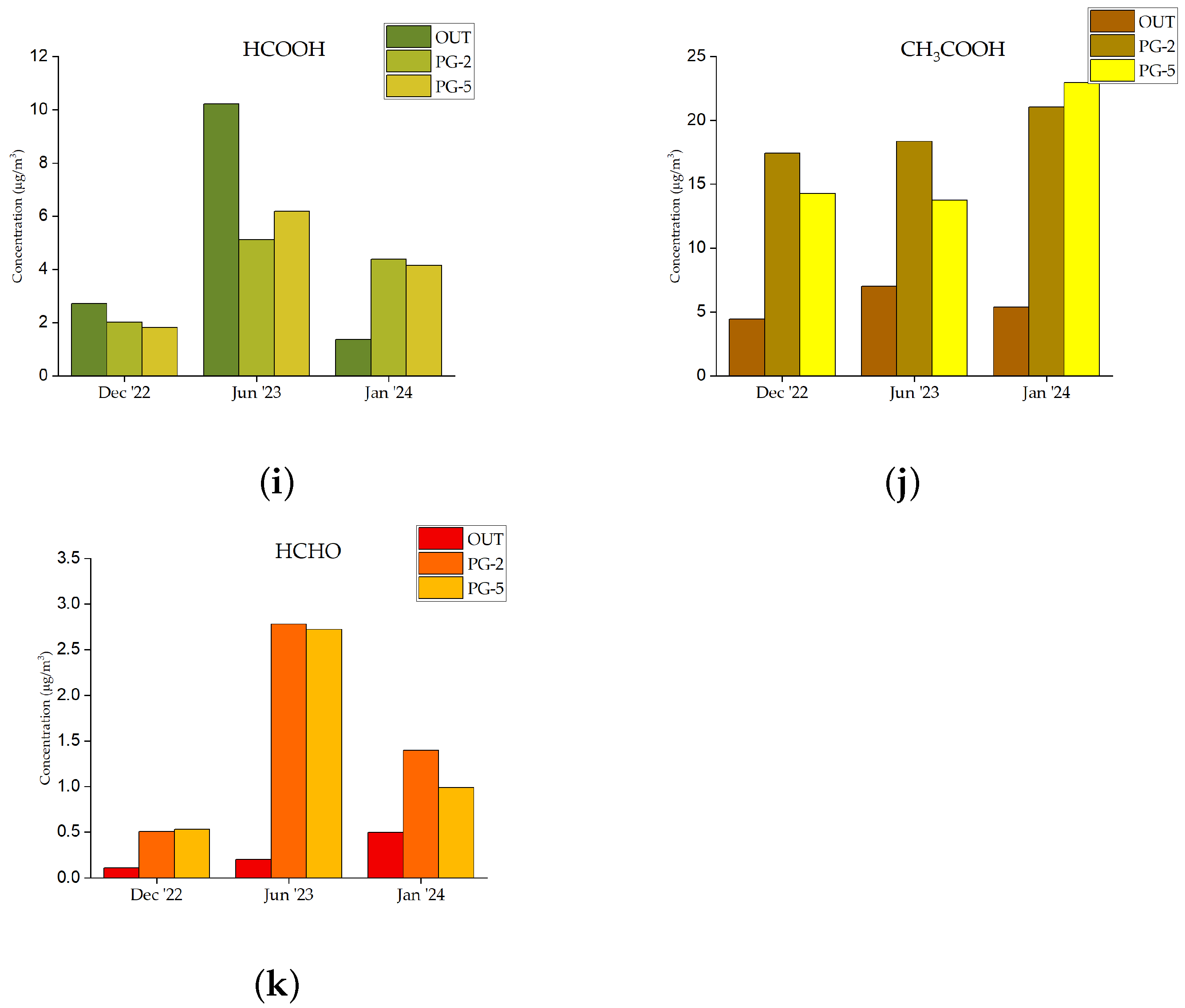
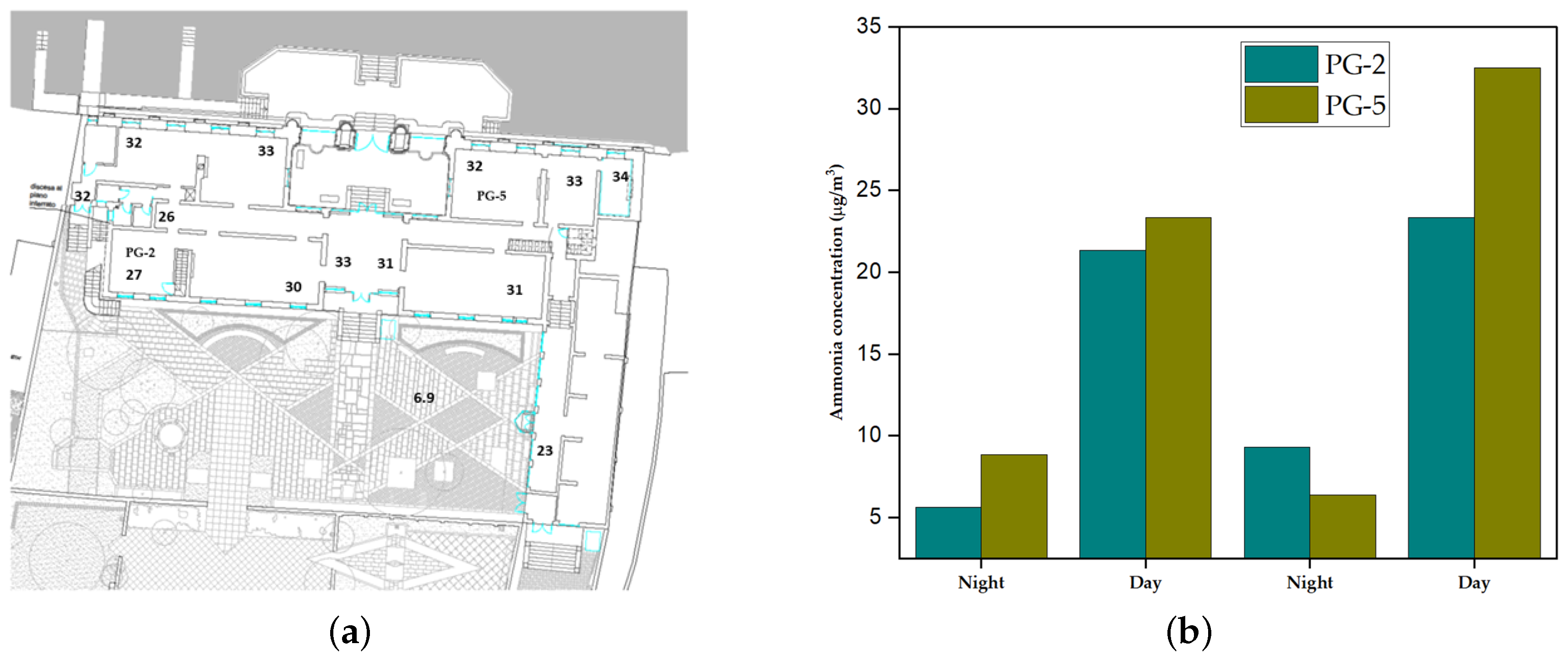
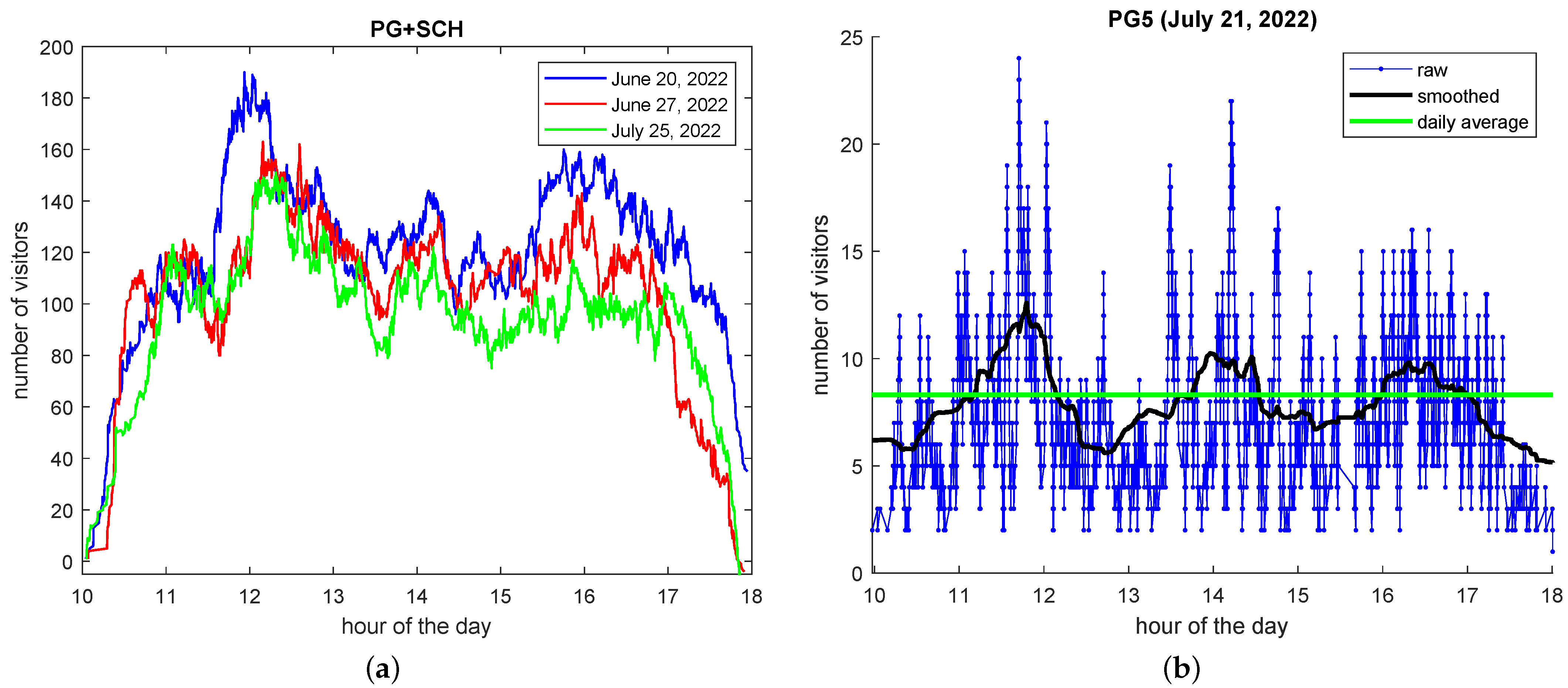
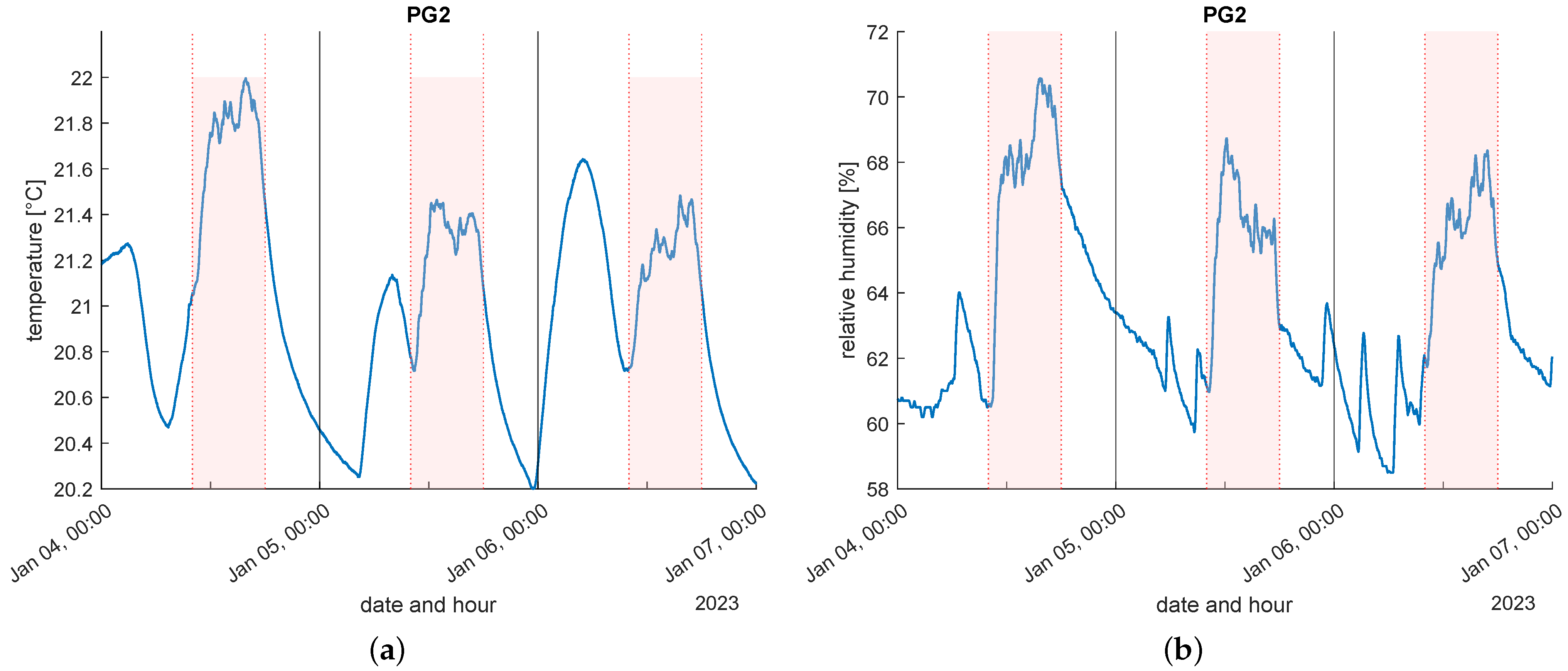



| Name | Tinytag Plus 2 TGP-4500 https://assets.geminidataloggers.com/pdfs/original/3751-tgp-4500.pdf (accessed on 14 July 2025) | HOBO MX1101 https://www.onsetcomp.com/sites/default/files/2023-01/17840-U%20MX1101%20Manual.pdf (accessed on 14 July 2025) |
| T range | [−25 °C, 85 °C] | [−20 °C, 70 °C] |
| T accuracy | ±0.45 °C at 25 °C | ±0.21 °C from 0 °C to 50 °C |
| T resp. time | 25 min to 90% FSD in mov. air | 7:30 min in mov. air 1 m/s |
| RH range | [0%, 100%] | [1%, 90%] |
| RH accuracy | ±3.0% RH at 25 °C | ±2.0% from 20% to 80% |
| RH resp. time | 40 s to 90% FSD | 20 s to 90% FSD in mov. air 1 m/s |
| frequency adopted | 3 s | 1 min |
| Monitored Parameter | Period | Sampling Time | Sampling Site | Visitors |
|---|---|---|---|---|
| SO2, NO2, NOx, HONO, HNO3, O3, NH3, CH3COOH, HCOOH, HCHO | 22 November 2022–13 December 2022 20 June 2023–10 July 2023 10 Janaury 2024–30 January 2024 | 3 weeks | PG-2, PG-5, outdoor (garden) | 16,250 20,417 11,879 |
| NH3 | 29 December 2022–10 January 2023 | 13 days | 13 in PG (first floor), 1 in SCHULHOF (ground floor), 1 outdoor (garden) | 15,934 |
| NH3 | 16 May 2023–18 May 2023 | 3 days (9:00 a.m.–6:00 p.m., 6:00 p.m.–9:00 a.m.) | PG-2, PG-5 | 2512 |
| T (°C) | RH (%) | ||||||
|---|---|---|---|---|---|---|---|
| Min | Max | Avg | Min | Max | Avg | ||
| 22 November 2022–13 December 2022 | PG-2 | 20 | 23 | 22 | 49 | 82 | 60 |
| PG-5 | 19 | 23 | 22 | 44 | 82 | 56 | |
| 20 June 2023–10 July 2023 | PG-2 | 21 | 36 | 24 | 45 | 79 | 56 |
| PG-5 | 20 | 35 | 23 | 46 | 65 | 57 | |
| 10 January 2024–30 January 2024 | PG-2 | 13 | 24 | 23 | 42 | 83 | 56 |
| PG-5 | 14 | 24 | 23 | 38 | 85 | 56 | |
| 29 December 2022–10 January 2023 | PG-2 | 19 | 23 | 21 | 51 | 70 | 60 |
| PG-5 | 18 | 21 | 20 | 55 | 75 | 64 | |
| 16 May 2023–18 May 2023 | PG-2 | 21 | 22 | 22 | 58 | 58 | 58 |
| PG-5 | 20 | 22 | 21 | 62 | 63 | 63 |
| Dec 2022 | Jun 2023 | Jan 2024 | |||||||
|---|---|---|---|---|---|---|---|---|---|
| PG-2 | PG-5 | Avg. | PG-2 | PG-5 | Avg. | PG-2 | PG-5 | Avg. | |
| SO2 | 0.85 | 0.70 | 0.78 | 0.40 | 0.60 | 0.50 | 0.22 | 0.30 | 0.26 |
| NO2 | 0.82 | 0.83 | 0.82 | 0.59 | 0.52 | 0.55 | 0.73 | 0.70 | 0.72 |
| NO | 0.70 | 0.61 | 0.66 | 0.60 | 0.74 | 0.67 | 0.90 | 1.24 | 1.07 |
| NOx | 0.77 | 0.75 | 0.76 | 0.59 | 0.59 | 0.59 | 0.77 | 0.82 | 0.80 |
| HONO | 3.5 | 3.7 | 3.6 | 13 | 20 | 16 | 1.4 | 1.50 | 1.5 |
| HNO3 | 0.71 | 0.25 | 0.48 | 0.07 | 0.04 | 0.05 | 0.37 | 0.72 | 0.55 |
| O3 | 0.08 | 0.13 | 0.10 | 0.09 | 0.09 | 0.09 | 0.23 | 0.20 | 0.22 |
| NH3 | 4.3 | 3.9 | 4.1 | 6.6 | 7.1 | 6.9 | 4.0 | 4.3 | 4.2 |
| CH3COOH | 3.9 | 3.2 | 3.5 | 2.6 | 2.0 | 2.3 | 3.9 | 4.3 | 4.1 |
| HCOOH | 0.74 | 0.67 | 0.70 | 0.50 | 0.61 | 0.55 | 3.2 | 3.1 | 3.1 |
| HCHO | 4.7 | 4.9 | 4.8 | 14 | 14 | 14 | 2.8 | 2.0 | 2.4 |
Disclaimer/Publisher’s Note: The statements, opinions and data contained in all publications are solely those of the individual author(s) and contributor(s) and not of MDPI and/or the editor(s). MDPI and/or the editor(s) disclaim responsibility for any injury to people or property resulting from any ideas, methods, instructions or products referred to in the content. |
© 2025 by the authors. Licensee MDPI, Basel, Switzerland. This article is an open access article distributed under the terms and conditions of the Creative Commons Attribution (CC BY) license (https://creativecommons.org/licenses/by/4.0/).
Share and Cite
Catrambone, M.; Cristiani, E.; Riminesi, C.; Onofri, E.; Pensabene Buemi, L. Assessing the Combined Influence of Indoor Air Quality and Visitor Flow Toward Preventive Conservation at the Peggy Guggenheim Collection. Atmosphere 2025, 16, 860. https://doi.org/10.3390/atmos16070860
Catrambone M, Cristiani E, Riminesi C, Onofri E, Pensabene Buemi L. Assessing the Combined Influence of Indoor Air Quality and Visitor Flow Toward Preventive Conservation at the Peggy Guggenheim Collection. Atmosphere. 2025; 16(7):860. https://doi.org/10.3390/atmos16070860
Chicago/Turabian StyleCatrambone, Maria, Emiliano Cristiani, Cristiano Riminesi, Elia Onofri, and Luciano Pensabene Buemi. 2025. "Assessing the Combined Influence of Indoor Air Quality and Visitor Flow Toward Preventive Conservation at the Peggy Guggenheim Collection" Atmosphere 16, no. 7: 860. https://doi.org/10.3390/atmos16070860
APA StyleCatrambone, M., Cristiani, E., Riminesi, C., Onofri, E., & Pensabene Buemi, L. (2025). Assessing the Combined Influence of Indoor Air Quality and Visitor Flow Toward Preventive Conservation at the Peggy Guggenheim Collection. Atmosphere, 16(7), 860. https://doi.org/10.3390/atmos16070860







